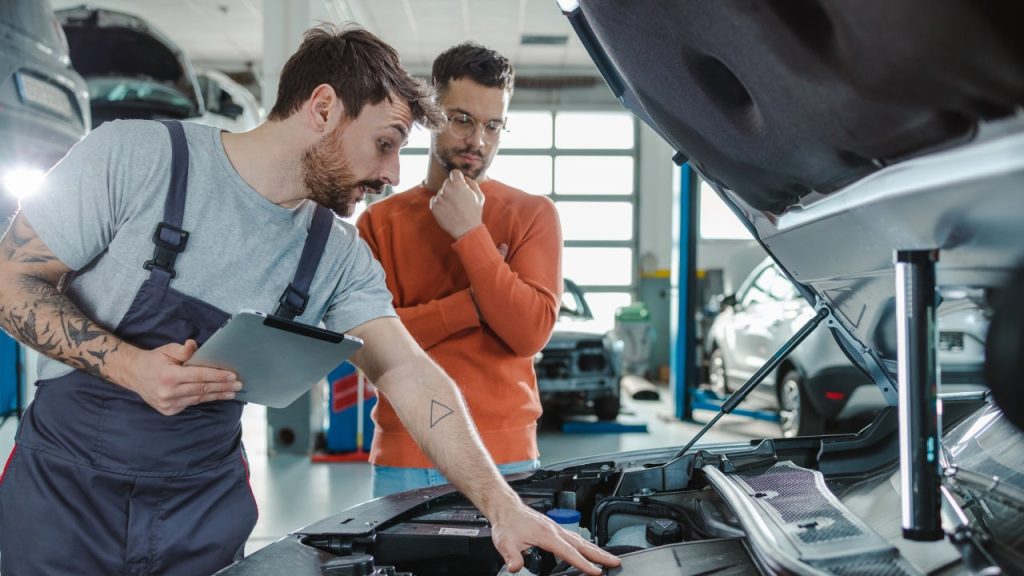The rapid development of vehicle technology has led to safer and more efficient cars, but it has also made vehicle repairs more complex. What might have been a simple fix two decades ago now likely involves electrical work, calibration and specialized labor. And when repair shops lack the vehicle information needed for a fix, they often have to pay for it or send you to a pricier shop, passing along these higher costs to drivers and insurers.
Legislation protecting the right to repair has the potential to reduce two of the hidden costs of car ownership: auto repairs and car insurance. But experts in the automotive world remain divided on the best way to protect consumers’ right to affordable, safe vehicle repairs. While many advocates in the insurance industry support a federal bill to guarantee consumers’ right to repair, collision repair specialists say that legislation might protect insurance companies more than it protects their customers.
What is the right to repair?
Thanks to increased technology in modern cars, auto repairs require more access to vehicle data, repair instructions and specialized tools than ever before. According to a study by CCC Intelligent Solutions, the average combustion engine passenger vehicle in 2024 has between 1,400 and 1,500 semiconductor chips powering everything from connectivity and infotainment to the vehicle’s powertrain and safety systems.
Computer chips make modern cars run — and they make them more complicated to fix. In order to tackle most vehicle repairs, technicians need access to resources from manufacturers — repair information, diagnostic equipment, specialized training and vehicle-generated telematics data. This allows them to diagnose issues, make repairs according to manufacturer instructions, and recalibrate sensors and cameras.
But for independent repair shops, getting access to repair data is easier said than done. According to a February 2024 study by the Auto Care Association that polled over 400 repair professionals, approximately 63 percent of independent auto repair shops have difficulty completing routine repairs on a daily or weekly basis due to repair restrictions. Fifty-one percent said that they send up to five vehicles per month to dealerships due to data restrictions.
“It’s a fairness issue,” says Justin Rzepka, executive director of the CAR (Consumer Access to Repair) Coalition. “It’s an affordability issue.” Most car owners prefer to bring their cars to independent repair shops, according to a recent study by Consumer Reports. Independent shops tend to be significantly cheaper than dealer service centers. They’re more likely to be willing to negotiate on price. If independent shops can’t complete vehicle repairs, consumer choice suffers — and costs go up.
If you do not have the ability to access your car’s information, do you truly own your vehicle? What is ownership if not control?
— Justin Rzepka, CAR Coalition Executive Director
Complex vehicles cost more to fix
Motor vehicles manufactured today are technologically complex in ways they weren’t as little as 10 years ago. According to researchers at the Institute for Electrical and Electronics Engineers (IEEE), even low-end vehicles today may have as many as 100 million lines of software code. Infotainment systems require ever-larger touchscreens; safety features rely on dozens of internal cameras and sensors; semiconductor chips power vehicle components from power steering to fuel injectors to torque sensors.
Consulting firm Deloitte Touche Tohmatsu Limited estimates that by 2030, electronics systems may make up as much as 50 percent of the cost of a new car. And research indicates that they’re already contributing significantly to the historic jump in repair costs.
According to AAA, the cost to repair advanced driver assistance (ADAS) components, such as collision mitigation systems, makes up 37.6 percent of the total cost of vehicle repairs, on average. In the case of a minor front collision, the average cost to repair ADAS components was $1,541 — just over 13 percent of the total cost of repairs.
It’s not just the cost of parts adding to repair bills. Technologically complex vehicles also require more labor hours, largely because more repair processes involve some form of diagnostic scan and post-repair recalibration of sensors and cameras. CCC Intelligent Solutions found that of repair appraisals for vehicles manufactured in 2014, approximately 60 percent required a scan, and just 6 percent required calibration. For vehicles manufactured in 2023, over 71 percent of appraisals required a scan, and nearly 28 percent required calibration.
You’re talking about technology that’s going to save people’s lives. All of those things are good, but they do add complexity to the repair.
— Aaron Schulenburg, Executive Director, Society of Collision Repair Specialists (SCRS)
A brief history of automotive right to repair laws
The early 2000s saw the first stirrings of right to repair activism in the U.S. automotive industry. However, automakers have long been opposed to such laws. Since 2014, the industry has operated under a memorandum of understanding signed by key stakeholders in the auto manufacturing industry and repair organizations. Under this non-binding agreement, automakers agreed to share vehicle data, tools and other information required for repairs for vehicles beginning with model year 2002. This memo was reaffirmed in 2023 by an updated Automotive Repair Data Sharing Commitment.
The voluntary agreement affirms that “consumers should have access to safe and proper repairs throughout a vehicle’s lifecycle” and promises to “ensure consumer choice in vehicle repair decisions.” However, the agreement states that diagnostic and repair information “shall be available for purchase” by vehicle owners and independent repair facilities. In other words, under this agreement, automakers reserve the right to charge you for the resources you or your mechanic need to fix your car.
For many advocates, including Rzepka and the CAR Coalition, the industry’s voluntary agreement isn’t good enough. In 2020, voters in Massachusetts approved a new law requiring automakers to give vehicle owners and independent shops the same access to data and diagnostic and repair information that’s given to dealerships. Three years later, Maine passed a similar law via ballot initiative. While automakers have filed suit in federal court to block the Massachusetts data access law, the Maine legislation has not yet come under fire.
Enter H.R. 906: The REPAIR Act
In February 2023, Neal Dunn (R-FL) introduced the Right to Equitable and Professional Auto Industry Repair Act (H.R. 906) in the House of Representatives. H.R. 906 — better known as the REPAIR Act — is a bipartisan federal bill focused on vehicle owners’ access to vehicle repair information. Among the law’s provisions are:
- Access to vehicle-generated data for vehicle owners and their designees with no restrictions such as fees or licenses
- A standardized access platform for vehicle-generated data
- Access to critical repair information and tools at a “fair, reasonable and nondiscriminatory cost”
- A ban on manufacturers requiring vehicle owners to use OEM parts outside of warranty repairs
In other words, the REPAIR Act says that vehicle owners must have free access to any data their vehicle generates, and manufacturers can’t put undue barriers or costs on resources needed to repair their cars — including by blocking consumers from using aftermarket parts for repairs. H.R. 906 cleared a markup by the House Energy and Commerce Subcommittee on Innovation, Data and Commerce earlier this year. The CAR Coalition expects a full markup by the Energy and Commerce Committee some time this month.
According to polling by the CAR Coalition, H.R. 906 is popular on both sides of the aisle. “Having your car repaired affordably shouldn’t be a political issue,” Rzepka says — and Congress seems to agree. As of September 2024, the bill has 56 co-sponsors: 28 Democrats and 28 Republicans.
The REPAIR Act also polls well with consumers. A survey sponsored by the CAR Coalition in the summer of 2023 found that over 90 percent of consumers want to choose where and by whom their vehicle is repaired, and that 75 percent would support legislation that stops manufacturers from limiting their data access.
Could the REPAIR Act reduce the cost of auto insurance?
It’s not just freedom of choice that makes the REPAIR Act an appealing prospect for consumers — or even the potential for cheaper repairs. According to industry experts, the right to repair could be key to lowering another cost of car ownership: auto insurance.
Tony Cotto, director of auto and underwriting policy at the National Association of Mutual Insurance Companies, says that a federal right to repair bill could mean relief for relentlessly rising auto insurance rates. “From the insurer side,” he says, “we believe that it’s one of the best ways to reduce the cost of vehicle ownership, which in turn reduces the cost of insuring your vehicle.”
As of September 2024, the average cost of car insurance in the U.S. is $2,348 per year for full coverage and $639 per year for minimum coverage. Car insurance costs are based in part on the amount that insurers expect to pay out for claims — and if auto repair shops have to pay more for tools and data, those costs go up. Repair restrictions can also increase insurance costs by extending the time necessary to complete repairs. According to the 2023 J.D. Power U.S. Auto Claims Satisfaction Study, the average repair cycle time for an auto insurance claim is just over 23 days — a 36 percent increase from 2022. In the same time period, the average cost of car insurance increased by 20 percent.
But while longer claims are certainly one key driver of higher insurance costs, vehicle data access may not be the root problem driving the trend. While a report by the U.S. Government Accountability Office found that 9 out of 14 independent repair stakeholders had experienced some degree of difficulty in accessing vehicle data, the report’s authors concluded that “it is hard to determine how common those limitations are.”
“I don’t think it’s an access issue,” says Aaron Schulenburg, Executive Director of the Society of Collision Repair Specialists (SCRS), one of the signing parties to the 2023 industry data sharing commitment. In his view, the industry’s voluntary commitment is working: collision repair shops, including independent shops, have access to the data, tools and information needed to make repairs. “We don’t routinely have members reaching out to us saying they don’t have what they need,” he says.
Instead, Schulenburg says, he often hears from collision shop owners that their customers are being turned away to dealerships or other shops because insurance companies deny charges needed to complete diagnostic and repair services in a safe and proper manner. “There’s nothing within the right to repair initiative,” he says, “that protects against an insurer doing that.”
Who covers the cost of vehicle complexity?
When vehicle complexity raises the cost of auto repairs, that cost has to go somewhere. For independent repair shops, the cost of vehicle complexity may take the form of higher overhead costs in the absence of right to repair laws that force manufacturers to set reasonable prices. Under the industry’s voluntary commitment, diagnostic and repair information, vehicle data, tools, education and training are all available to independent shops — but they carry a price tag.
Schulenburg says the cost of access doesn’t necessarily put an undue burden on repair shops. “There are investments that are necessary in a professional environment in doing proper service in whatever your trade is,” he points out. But for some independent shops, the cost of doing business may be unsustainable in light of repair restrictions. The Auto Care Association estimates that restrictions on vehicle data cost independent auto repair shops around $3.1 billion each year, with 45 percent of independent shops reporting average costs of $2,400 or more to purchase automaker data and tools.
Some of those costs pass on to insurance companies in the form of larger claims that take longer to resolve. And there are added costs for insurers beyond the repairs themselves, such as longer rental periods. A standard rental reimbursement endorsement for an auto insurance policy covers the cost of a rental car during covered repairs for 30 days — but policyholders are often dependent on rental vehicles for more than 30 days while their claim is resolved. “We are seeing that be exhausted more frequently than ever before,” Cotto says.
Finally, the cost of vehicle complexity trickles down to consumers when insurance companies raise prices in response to higher claims processing costs — and when policyholders reach the limits of their policy. Schulenburg points out that insurance companies can choose to deny claims for charges necessary to use the specialized tools and resources required for more complex repairs. When that happens, consumers may be forced to pay more of the cost to repair their vehicle safely.
“The narrative needs to shift,” Schulenburg says. Rather than focusing on whether repair shops have access to data — in his view, they already do — he argues that it’s time to focus on other barriers to safe, affordable vehicle repairs. “If this is about repair, we should make sure that consumers’ right to a safe and thorough repair is protected.”
So, how should you get your car repaired?
While experts may disagree on whether the REPAIR Act is the ideal fix for the industry’s woes, they agree on one point: that no barriers should stand between consumers and safe vehicle repairs.
“Everything we do starts and stops at safety,” says Rzepka. In the CAR Coalition’s statement of key principles, “safety first” leads the way. Cotto agrees: “Our members want cars fixed, and they want them fixed correctly.”
With the complexity and cost of auto repairs on the rise and the REPAIR Act still in committee, it’s important to know how to advocate for your own right to safe and thorough repairs. Consider the following tips to help you get your car repaired without cutting corners or risking a drawn-out claim process:
- Review and understand your insurance coverage: Read the details of your auto insurance policy carefully to understand what’s covered — and what might not be. If you have comprehensive and collision coverage, you may also want to review your deductibles and decide whether to raise or lower the cost of filing a claim.
- Build relationships with auto repair businesses in your area: When your car is damaged, you have the legal right to bring it to any repair professional you choose. While your insurance company may recommend a shop in their own network, it’s your choice whether or not to follow that recommendation — and working with a shop you know and trust may make it easier to save money on safe and proper repairs.
- Get multiple repair estimates: Before you agree to let a shop make repairs, be sure that you understand all of what you (or your insurance company) are paying for. Especially for complex repairs, it’s worth getting multiple estimates, including breakdowns of the cost of parts and labor for each part of the process.
- Work closely with your insurer if you need to make a claim: If your car needs repairs that are covered by insurance, follow up regularly with your insurance company and the adjuster assigned to your claim in order to ensure the repairs are being covered appropriately.
- Be prepared to negotiate if your claim is denied: If an insurance company denies all or part of your claim, you have options. You can appeal the decision and negotiate with the adjuster to resolve the dispute.
Read the full article here
















